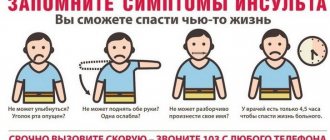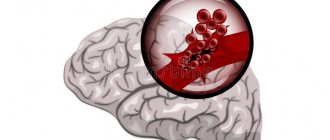Causes of coma
The causes of coma can be very diverse.
For example, a person may become immobilized and unconscious due to severe damage to both the head and brain, a serious viral infection such as meningitis, a lack of oxygen to the brain for a long time, or poisoning from any drugs or chemicals. , as a result of alcohol intoxication, etc. In general, the mechanism for the appearance of coma as a result of one of these reasons is quite simple: part of the brain cells wipes off and stops functioning, as a result of which the person loses consciousness and falls into a coma.
Coma is not an independent disease; it is a severe complication of the central nervous system, which is based on damage to the nerve pathways. The cerebral cortex perceives signals about the surrounding world not directly, but through the reticular formation. It passes through the entire brain and is a filter that systematizes and passes through nerve impulses. If the cells of the reticular formation are damaged, the higher part of the brain loses contact with the outside world. The person falls into a state called coma.
The nerve fibers of the reticular formation can be damaged both directly physically and through exposure to various chemicals:
- Physical damage. It can occur in conditions such as cerebral stroke, trauma (bullet wound, bruise, hemorrhage).
- Chemical compounds that lead to damage to nerve cells of the reticular formation are divided into 2 types:
- Internal, which are metabolic products and are formed as a result of diseases of the internal organs. Internal damaging factors are: reduced oxygen content in the blood (hypoxia), high or low levels of glucose and acetone bodies (for diabetes), ammonia (for severe liver diseases).
- External, which enter the body from outside. External intoxication of the nervous system can occur with an overdose of narcotic drugs, sleeping pills, poisoning with neurotropic poisons, and exposure to bacterial toxins in infectious diseases.
A special damaging factor that combines signs of physical and chemical damage to the reticular formation is an increase in intracranial pressure. It occurs with traumatic brain injury, tumors of the central nervous system.
Emergency care and treatment
It is not entirely appropriate to talk about treatment, since a drug-induced coma is a deliberately induced condition, not a disease. Therefore, it is correct to remove the patient from such a state. The duration of coma depends on the location and extent of brain damage. They are removed from it when the problem and the consequences of the disease are eliminated.
Treatment primarily involves maintaining the patient’s vitality, so it begins from the moment first aid is provided. The doctor helps the patient clean the oral cavity, does not allow the tongue to fall back, so as not to cause asphyxia.
If resuscitation procedures are required, chest compressions and artificial respiration are performed. The patient is put on an oxygen mask or a breathing tube is inserted, and medications are administered to normalize and relieve.
The second stage of treatment begins in the hospital after the patient has been examined. For treatment to be effective, it must be aimed at eliminating the causes that led to the coma.
The treatment method may include the following components:
- Surgical intervention. In case of traumatic brain injuries, extensive hemorrhages, or tumor processes in the brain, surgery is performed to eliminate this process.
- Antibacterial therapy. If there is an infection or possible infection due to injury, antibiotic therapy is given. It is also recommended if pneumonia develops due to mechanical ventilation.
- Forced diuresis. If the coma is caused by intoxication, it is necessary to remove toxins from the body. The patient is given intravenous fluid and induced to urinate to remove toxic substances through the kidneys.
Since in coma there is suppression of the vital functions of the body, emergency care will include resuscitation procedures in the form of artificial respiration, possibly starting the heart, as well as help to eliminate the causes of its occurrence: removing intoxication, hypoxia, stopping bleeding, replenishing dehydration or exhaustion, reducing or increased glucose levels, etc.
Treatment of coma is carried out in the intensive care unit and also begins, first of all, with the treatment of its causes, followed by the elimination of cerebral consequences and rehabilitation. The specifics of therapy depend on the underlying cause of the condition and the resulting brain damage.
Mechanism of action of coma
This human condition is based on two main mechanisms:
- bilateral damage to the cerebral cortex;
- primary or secondary damage to its trunk, where the reticular formation is located, which maintains the cerebral cortex in tone and activity.
This is a cerebral coma.
Damage to the brain stem occurs when a person has a stroke or traumatic brain injury. Secondary disorders, as a rule, occur when metabolic processes in the body change, for example, in case of poisoning, diseases of the endocrine system, etc.
In addition, there are cases of a combination of both mechanisms of coma, which is observed quite often. It is believed that this is the line between life and death.
As a result of this, the normal transmission of nerve impulses in the human brain becomes impossible, the activity of all structures that switch to an autonomous mode is lost. Thus, the brain temporarily ceases to function and control the processes occurring in the body.
Drugs used
| No. | Group of drugs | Scope of application |
| 1 | Barbiturates | They help put the patient into a state of sedation, reduce cerebral edema, and stimulate the body's protective properties. |
| 2 | Benzodiazepines | Drugs from the group of tranquilizers. In small doses they are used to treat various sleep disorders, and also as an anticonvulsant. The duration of the coma in this case should not exceed three days. |
| 3 | Propofol | The drug is used to put a patient into an induced coma for a short period of time. The drug effectively protects the brain, therefore it is used for vascular lesions and as a postoperative coma. The duration of sedation usually does not exceed several hours. |
| 4 | Opiates | They belong to the group of narcotic analgesics, but are practically not used today. Coma is a side effect of using such drugs. |
How does a person feel in a coma?
In pathology, there are several stages, each of which has its own distinctive features.
- Previous stage. The precoma state can last from a minute to 2 hours. Signs include confusion, in which periods of lethargy are abruptly replaced by nervousness and agitation. Coordination of movements may be impaired.
- Coma 1st degree. It is characterized by symptoms such as increased muscle tone, tendon reflexes, and difficulty swallowing food. In this case, the pupil begins to react weakly to light.
- Stupor 2nd degree. The person is immobilized and has no contact with the outside world. The pupils narrow, there is no reaction to light, breathing is impaired. In rare cases, tension in the limbs may be observed, quickly followed by relaxation, and chaotic movements of the patient. Involuntary urination or bowel movements may occur.
- Coma 3rd degree. The person is unconscious, there is a decrease in blood pressure and body temperature. Interruptions in the respiratory rhythm and convulsions are possible.
- Stupor 4 degrees. There is no manifestation of any reflexes. Human life is supported only by medical equipment (ventilator and parenteral nutrition). The stage is characterized by the process of dying of the body.
The classification of pathology is based on the reasons that led to its development. There are the following types of comas:
- Diabetic. Pathology can occur in people suffering from diabetes. The cause is an increase in blood glucose levels. In this condition, the patient's mouth emits a strong odor of acetone.
- Hypoglycemic. It also develops in diabetic patients, but its cause is a decrease in blood glucose. Characterized by a strong feeling of hunger.
- Traumatic stupor. Occurs against the background of brain damage due to traumatic brain injury. A distinctive feature is the appearance of vomiting at the precoma stage.
- Meningeal pathology. It is observed in cases where the cerebral cortex is affected by meningococcal infection. The state of precoma is marked by severe pain in the head. The patient cannot raise his leg in a straight position. If you tilt the head of such a patient, his knees will bend. A rash may occur on the skin and mucous membranes of external and internal organs.
- Cerebral cerebral coma. Becomes a consequence of the development of tumors in the brain. The state preceding coma is accompanied by a gradual increase in headaches, vomiting, and difficulty eating. The same symptoms are characteristic of coma, which occurs against the background of a brain abscess due to inflammatory diseases (sinusitis, tonsillitis, etc.)
- Hungry stupor. The result of grade 3 dystrophy, which occurs after prolonged fasting. Most often it develops due to a lack of protein in the body, which is responsible for the functioning of vital organs, incl. brain.
- Epileptic stupor. Occurs after a severe seizure of epilepsy. It is characterized by dilated pupils, lack of reflexes, decreased blood pressure, etc. Without timely medical intervention, it can lead to death.
There is a food coma, which has nothing to do with loss of consciousness. This is the drowsiness that some people experience after or during a heavy meal.
Only a specialist can distinguish fainting from a coma state, so at the first symptoms of pathology you should call an ambulance.
Before doctors arrive, first aid for a coma is provided as follows: the patient is placed on his side to minimize the risk of the tongue sticking into the throat, the buttons on the chest are unbuttoned, and the collar is loosened. If a person regains consciousness, you should find out what sensations he experiences, what chronic diseases he has.
Measures to maintain the functionality of vital organs can be reduced to supporting breathing, the circulatory system, therapy with anticonvulsants, antiemetics, sedatives and other drugs. Gastric lavage, administration of glucose, vitamins, etc. can be performed.
After complex treatment has been completed, the patient has emerged from a comatose state, he may suffer from memory impairment and lack of concentration. A person may not have psychological problems until a coma sets in, and after it they appear (aggression, irritability, development of depression).
Coma usually lasts from one to several weeks. However, there are a huge number of cases where this condition lasted much longer - up to several months and even years.
The patient's return to consciousness occurs slowly. At first, he may come to his senses for only a few minutes or hours, and over time this time increases. A person’s return to a normal state largely depends on the depth of the coma he experienced, as well as on a number of reasons why this condition arose.
The consequences of coma are sometimes very severe. During this condition, the brain is damaged, so the person may not recover some body functions. Very often, after a coma, people cannot walk, make movements with their hands, and there is a slowdown in speech activity or its complete absence.
After a first-degree coma, a person, as a rule, quickly comes to his senses, and his body in most cases does not lose its abilities. After a third-degree coma, the brain is almost completely destroyed. Accordingly, after this, a person no longer has the opportunity to live a full life.
The consequences of a coma can also be memory impairment, changes in human behavior (aggressiveness or lethargy), decreased attention and reactions. After suffering a comatose state, people recover their abilities for a very long time, even in the everyday sphere - feeding themselves, bathing, changing clothes, etc.
The experiences and sensations of a person who is in a comatose state have been studied for many years in various countries around the world. However, there are still no reliable facts about this.
Nevertheless, scientists still made some conclusions, for example, it has been scientifically proven that even those people who are in a state of deep coma experience certain states, and the brain has some activity. Thus, it turned out that a patient in a coma has the internal ability to respond to external stimuli.
The patient internally reacts to tactile sensations, which can also be confirmed by rapid heartbeat, changes in breathing intensity, or changes in blood pressure. This can confirm that a person experiencing a comatose state reacts in a certain way to events occurring in the outside world and responds to them. What people feel in a coma can be told by those who have successfully come out of it.
Many people who have experienced this condition share their feelings and experiences. Some of them claim that they were in a kind of altered state of consciousness, when they seemed to travel between worlds, could see their deceased relatives and even talk to them. Other patients claim that they were conscious, heard the speech of doctors, relatives who were next to them, but could neither move nor in any way confirm their ability to understand everything.
On average, a coma lasts 1-3 weeks. However, there are often cases when it lasts for a longer time - people can lie unconscious for years.
The patient's return to consciousness occurs gradually. At first he comes to his senses for a couple of hours, then this time increases more and more. As a rule, the body goes through several different stages during this time. And the consequences will depend on how he copes with the load placed on him.
Since the brain is affected during a coma, one should be prepared for the fact that the patient may not recover many vital functions. For example, quite often people cannot walk, talk, move their arms, etc. Naturally, the severity of the damage directly depends on the degree of coma the patient was in.
Among the most common problems faced by a person who has been in a coma are memory impairment, decreased attention, and various changes in behavior (lethargy, aggressiveness, etc.). Sometimes relatives do not even recognize the person close to them.
Also, after a coma, many patients take a long time to restore everyday skills. For example, they cannot eat on their own, wash themselves, etc.
One of the signs of a person's recovery and recovery after a coma is the desire for some kind of activity. However, in this case, you should not be overly happy and immediately give the patient maximum loads - too abrupt a return to normal life can have a negative impact on his condition and lead to a noticeable deterioration in well-being.
Naturally, you should be prepared for the fact that you will have to spend a lot of effort on recovery. The list of important rehabilitation measures includes gymnastics (to restore motor skills), maintaining hygiene, proper nutrition, walks, adequate sleep, taking medications and regular consultations with a doctor.
Coma after a stroke: chances of survival for different patients
A comatose state, regardless of the reasons for its development, causes serious changes in the human body: the function of the central nervous system and brain is disrupted, and all internal organs suffer. We can say with confidence that coma after a stroke, the chances of survival after which do not tend to 100%, precedes significant changes in a person’s life.
It is known that a coma more often occurs in the presence of several factors: complex diseases before the attack, the patient’s retirement age, hemorrhagic form of hemorrhage. But, if you look deeper, you can find more interesting causes of coma after a stroke.
Causes of coma
The chances of surviving a coma due to a stroke vary from patient to patient.
During coma, apoplexy occurs, which causes increased hemorrhage, and the patient loses the ability to remain in a normal state.
It is known that coma is a common consequence after a stroke, after which you can survive only with timely medical care . This is why coma forms:
- the brain swells - against this background, vascular damage, heart attack, and hypoxia develop;
- severe bleeding is the cause of hemorrhagic stroke;
- ischemia – insufficient supply of blood and oxygen, which leads to the death of neurons or their temporary incapacity;
- infectious or autoimmune lesions of the circulatory system;
- angiopathy is a disease that causes the accumulation of blood protein in vessels that block the blood flow;
- atheroma – change, destruction of the walls of blood vessels, loss of their functions;
- severe intoxication - appears due to chemicals;
- callagenosis is a change in connective tissue that causes coma after a stroke.
Some patients believe that only a hemorrhagic stroke can cause coma, but this is not true. Even after an ischemic attack, the chances of survival if a person falls into a coma are greatly underestimated.
Coma develops with ischemic stroke of several forms: atherosclerotic lesions, cardioembolism, lacunar stroke, hemodynamic form of the pathology.
Against the background of hemorrhagic changes in the arteries of the brain, ischemic strokes rarely cause coma. It is also surprising that recovery from a coma after a stroke of this type can occur independently.
Symptoms and formation of coma
The word “coma” began to be used by the Greeks, and it is translated from the ancient language as “sleep”. After all, in this state a person sleeps for a very long time and deeply, but it is impossible to wake him up. Organs in a coma function, but in a slow mode, sometimes requiring the support of special devices. If a person is in a deep coma, then the following condition occurs:
- unconsciousness during the entire time of being in a coma;
- spontaneous bowel movements of the body;
- lack of any response to tactile stimuli, including pain, as well as to sound and light;
- no sleep/wake cycle.
In patients after a stroke, coma progresses differently; some people retain swallowing functions. Tube feeding is not required for this condition. Some even have a reaction to bright light and other actions: unconscious laughter, grimaces, spontaneous movements. However, the person does not understand what is happening, his eyes are usually closed, he does not hear anything .
The condition can occur within a few hours after the stroke. In rare cases, you can suspect that the patient is about to fall into unconscious sleep by certain symptoms: dizziness, severe weakness and drowsiness, vision problems, severe yawning, numbness or paralysis of the limbs, and confusion.
If doctors can determine that a person will soon be in an unconscious sleep, the chances of surviving a stroke increase significantly.
Degrees of condition
How long a coma will last after a stroke depends on the initial condition of the patient, but this time is usually 2-10 days. Less often, the patient is in a state of sleep for less than 24 hours. A person is rarely unconscious for several years or months after a blow.
It is impossible to determine exactly at the moment sleep begins how many people will remain in it.
But there is one important pattern: the longer a person is in this state, the lower the risks of surviving and returning to normal life.
The duration of sleep also affects the ease of recovery after being in a coma. In 70-90% of clinical cases, a person remains with 1-3 degrees of disability, and important body functions are lost.
There are 4 degrees of coma after a stroke:
- Pre-coma . The person is in normal consciousness, his muscles are working, but lethargy and loss of tone are noticeable. Partial numbness of the skin occurs. At this stage, the transition to unconsciousness can be prevented
- Second degree . At this moment, the person falls into a deep unconscious sleep and stops responding to any stimuli. Breathing gradually changes: it becomes noisier and more intermittent, and the muscles begin to contract involuntarily.
- Third degree . It is formed mainly during a major stroke. The person completely loses consciousness, physiological reactions, including muscle cramps, go away. The temperature is decreasing.
- Fourth degree . In this case, the chances of surviving a coma caused by a stroke are almost zero. Even spontaneous breathing, which remains a reflex, is absent. The person is connected to special devices.
In unconscious sleep, a person needs special care from medical personnel: he is fed, served, and kept alive in accessible ways.
Main consequences of the condition
There are several outcomes that can result from coma after a stroke. Firstly, the patient will return from a dangerous condition with (in rare cases, complete) restoration of vital functions. Secondly, death as a result of brain death, which can occur due to severe hypoxia.
Thirdly, a way out of the situation without restoration of functions, with preservation of paralysis and paresis, as well as with impaired memory and intelligence. Fourthly, the transition to a vegetative state with the preservation of limited reactions to stimuli, while the person cannot speak or think.
Proven fact: full restoration of health is possible only in 10% of cases.
What can lead to death?
The chances of surviving a coma after a stroke are relatively high, but there is no hope of full recovery. There are some factors that lead to mortality:
- Increased concentration of creatine in the blood.
- Severe cramps that persist for more than 2 days.
- Age from 60 years, after 70 years the chances of survival are almost zero.
- Complete loss of respiratory reflexes and the need to connect to a device.
- Inability to perform MRI.
But there are also positive forecasts, which are due to the high activity of the nervous system and other factors:
- the cause of the disease has been established, which greatly improves the quality of treatment;
- first aid was provided on time;
- The central nervous system retains compensatory ability.
Brain damage can only be accurately determined after recovery from a coma, which occurs gradually.
With grades 3 and 4, coma during a stroke ends unfavorably.
Death most often occurs after 1-3 days when emerging from a coma, when the brain and other organs begin to actively work, revealing serious disorders. Death in a coma can occur if:
- the patient is over 70 years old;
- unconscious sleep occurred after the second attack;
- physiological reactions of the body are completely absent;
- the brain stem does not work;
- Tomography shows extensive tissue damage.
Relatives need to be prepared for the worst consequences. But, even if the patient has come out of a coma, in order to increase the chances of survival, rehabilitation must be approached with all responsibility.
Artificial coma
Introduction to an artificial sleep state is necessary for medical reasons. Most often this occurs in the presence of dangerous, active changes in the structures of the brain: edema, compression, extensive hemorrhages.
Artificial immersion in sleep replaces anesthesia during a crisis, constricts blood vessels and cerebral flow.
With its help, it is possible to prevent tissue death and reduce the amount of administered drugs in intensive care settings.
After an induced coma, as soon as the condition has stabilized, the medical staff does their best to help the patient get out of the state, restoring the functioning of the organs.
Coming out of unconscious sleep at any age takes some time; it does not happen that a person wakes up unexpectedly and suddenly. First, the first signs of reflexes appear, then consciousness returns. This may take several days or even weeks. Once all functions have been restored, the complex rehabilitation process begins. The chances of survival if 3-4 days have passed after waking up increase significantly.
Source: https://nevrology.net/sindromy-i-zabolevaniya/insult/shansy-vyzhit-posle-komy.html
Classification of coma
Coma states are divided into several types depending on various factors and symptoms. The main classifications are those that differ in the causative factor and the depth of coma.
Due to the occurrence of coma, it happens:
- with a primary neurological disorder (when it was caused by a certain process in the nervous system);
- with a secondary neurological disorder (when the cause of coma is in no way connected with the nervous system).
Establishing the cause of this condition is necessary in order to correctly determine the patient’s treatment tactics.
Who can be classified according to 2 groups of criteria: 1) depending on the reason that caused it; 2) according to the level of depression of consciousness. Depending on the causes, comas are divided into the following types:
- traumatic (for traumatic brain injuries)
- epileptic (complication of status epilepticus)
- apoplexy (the result of a cerebral stroke), meningeal (develops as a consequence of meningitis)
- tumor (space-occupying formations of the brain and skull)
- endocrine (with decreased thyroid function, diabetes mellitus)
- toxic (with renal and liver failure).
However, such a division is not often used in neurology, since it does not reflect the true condition of the patient. The classification of coma based on the severity of impaired consciousness - the Glazko scale - has become more widespread. Based on it, it is easy to determine the severity of the patient’s condition, build a scheme of emergency treatment measures, and predict the outcome of the disease. The Glazko scale is based on a cumulative assessment of three patient indicators: speech, presence of movements, eye opening. Points are assigned depending on the degree of their violation. Based on their sum, the patient’s level of consciousness is assessed: 15 – clear consciousness; 14-13 – moderate stunning; 12-10 - deep stun; 9-8 – stupor; 7 or less – comatose state.
According to another classification, which is used mainly by resuscitators, coma is divided into 5 degrees:
- precom
- coma I (in Russian medical literature called stupor)
- coma II (stupor)
- coma III (atonic)
- coma IV (extreme).
Consequences of comatose states
The longest coma was recorded in the USA. At the end of 1969, on New Year's Eve, a 16-year-old girl with pneumonia was hospitalized. If this were an ordinary case in medical practice, she would have undergone treatment and returned to a full life. But Edward O'Bara suffered from diabetes. On January 3, insulin did not reach the circulatory system, and the girl lost consciousness for many years.
The last phrase of the modern “Snow White” was a request to her mother not to leave her. The woman kept her word: she spent thirty-five years at her daughter’s bedside. She celebrated all her birthdays, read books to her and believed in the best. I only left to sleep and shower. In 2008, the mother died, and the sister of an unusual patient took on her burden.
In November 2012, at the age of 59, Snow White died. Thus, the longest coma lasted 42 years.
It is noteworthy that the poor thing spent all her unconscious years with her eyes open. She did not see or hear those around her, did not react to anything. Edward O'Baras was able to close his eyelids only on the day of his death.
Until recently, doctors were sure that only the first month was between life and death. Then his return to consciousness is impossible. Some relatives of patients were not happy with this situation, and they waited for years at the bedside of a loved one until he woke up.
The longest coma, after which the patient began to react to others, lasted 20 years. This is how many years American Sarah Scantlin spent unconscious after she was hit by a drunk driver. To be precise, she spent 16 years unconscious. After which she began to communicate with loved ones using her eyes. After another 4 years, some reflexes and speech returned to her. True, after waking up, Sarah sincerely believed that she was still 18 years old.
In fact, the longest coma after which a person woke up happened to a resident of Poland, Jan Grzebski. The Pole spent 19 years unconscious. When Ian woke up, he was most amazed at the number and range of goods in the stores. And for good reason. He “fell asleep” in the early eighties, when martial law was introduced in the country. Grzebski woke up in 2007.
The longest coma from which a person emerged forced scientists to return to the study of this unconscious state. It is now known that the brain can repair itself. True, it is not yet clear how to “turn on” this mechanism.
African researchers believe a cure for coma may be found. According to them, it is possible to temporarily bring a person to consciousness today. Some sleeping pills have such properties. However, this issue has been little studied.
So far, according to observers, the most difficult thing for a person who has been between life and death is psychological adaptation. It is difficult for the patient to believe that he has become older, his relatives have aged, his children have grown up, and the world itself has become different.
Some people, after returning from deep sleep, simply do not understand their loved ones. So, for example, the Englishwoman Linda Walker, upon waking up, began speaking in the Jamaican dialect. Doctors believe the case is related to genetic memory. Perhaps Linda's ancestors were native speakers of this language.
Why and under what circumstances does coma develop during a stroke?
Content
Stroke is considered a very dangerous disease, which more often than others provokes the patient’s disability and even death. Coma during a stroke develops as a result of extensive death of brain cells due to a hemorrhagic or ischemic attack.
A breakthrough in the walls of blood vessels due to an unexpected strong increase in pressure provokes hemorrhage in the brain and, under the influence of the entire mass of blood, compression begins at the sites of damage and the formation of edema.
With the development of an ischemic attack, coma begins only in the case of extensive damage to neurons, which cease to receive enough oxygen. With a milder course, this complication can be prevented or, with the help of resuscitation measures, the patient can quickly return to consciousness.
Features of coma symptoms after a stroke
Translated from Greek, coma means sleep. In the deepest stages of this disorder, it is simply impossible to awaken the patient or force him to react in any way to external influences. The person seems to be disconnected from life - there are no reflexes, the pupils narrow and do not respond to exposure to light, the body does not respond to pain, involuntary urination and defecation are noted.
Coma after a stroke can last from two to six days, in rare cases - several months or even years. A person, as a rule, can take food due to the preservation of the swallowing reflex, but in other abilities he exists vegetatively.
Coma, just like with other diseases and abnormalities in the functioning of the central nervous system due to complications of the underlying pathology, is characterized by a gradual progression. In addition, it characterizes coma during a stroke: the prognosis of the course and the success of treatment of the underlying disease in the future.
As a rule, during a hemorrhagic attack, manifestations of the first stage of damage can be noticed already in the first minutes of hemorrhage in the brain - blurred vision, dizziness, confusion and clouding of consciousness, or unusually severe drowsiness, nausea.
How to care for a patient in a coma
When a person is in a coma after suffering a stroke, he needs constant care. First of all, this applies to the constant presence of specially trained medical personnel nearby.
The patient needs to be fed regularly; the doctor decides on the number of meals. In addition, it is important to provide measures to prevent the formation of bedsores. During a comatose state, a person does not feel anything at all and cannot move, so the formation of bedsores is inevitable in the absence of special preventive measures.
The process of a patient coming out of a coma
The patient's recovery from a coma after a stroke is always gradual, with lost body functions returning in the same order in which they were lost.
- Initially, the pharyngeal and corneal reflexes, the response of muscles and skin are restored, the patient can already move his fingers.
- Then speech and consciousness resume, but at the same time confusion and clouding of consciousness, delirium and hallucinations may occur.
This usually happens in such a way that the body’s functioning is fully restored only after several months, and at times speech and memory are lost forever.
During the recovery period, the patient and his relatives must be patient and not lose hope for the complete restoration of the body and all functions of nervous activity.
Even small progress, for example, the ability to tie a belt on your own or pronounce words or write letters should evoke a persistent desire to learn further.
Brain cells that die after an attack will not recover, but another area can work for them, so all lost skills can be fully restored.
It is a mistake to believe that a comatose state during a stroke will not cause consequences and that a person will quickly recover from the pathology or will immediately feel very good. In reality, the dynamics of the processes of restoring the full functioning of the body is always characterized by declines and rises. Sometimes the differences between them are almost invisible, sometimes noticeable deterioration of the condition develops, but despite this, the human brain never fully reveals its capabilities, so one should always hope for success. Belief in a good outcome is an integral part of successful treatment.
(No votes yet)
What is an induced coma?
From a medical point of view, this is a temporary immersion of the patient in an unconscious state. The activity of the cerebral cortex and subcortex is inhibited and all reflex functions are completely disabled.
Artificial coma is used only in the most extreme cases. That is, when there is no other way to protect the patient’s body from irreversible brain changes that threaten his life. This happens with swelling of brain tissue and compression effects on them, as well as with hemorrhage or bleeding accompanied by severe traumatic brain injuries or pathologies of cerebral vessels.
An artificial coma can be used to replace general anesthesia in cases of emergency surgery of a large volume or directly on the brain.
Possible complications
About half of patients after an induced coma experience many side effects and complications. Problems especially often arise when removing from sedation patients who have undergone operations associated with brain injuries, stroke, and vascular damage.
Among the side effects, the most common are problems with the respiratory system, and the development of pneumonia is possible. The patient may also be bothered by pain in the heart, problems with intestinal motility, and kidney function. There is a sharp decrease in the body's protective functions. From the nervous system, disturbances in speech functions, memory impairment, and persistent amnesia are possible.
Due to the development of severe complications, before introducing the patient into sedation, the doctor assesses the possible risks. All the pros and cons of the procedure are weighed. Since the effects of an induced coma may be irreversible, the opinion of several doctors is required. For this purpose, a collegial commission is assembled to decide whether this procedure is necessary.
Artificial coma is a protection of the brain created by reducing the rate of metabolic processes in the brain and in the bloodstream. The subject is temporarily immersed in a vegetative (unconscious) state. It is characterized by inhibition of the work of the cortex and subcortex, disabling functions. Therefore, a person in this state looks lifeless.
The effect of a medicated coma is aimed at suppressing brain functions. And since the human brain has not been fully studied, complications may arise. To begin with, it should be noted that there are side effects with long-term use of mechanical ventilation. This effect manifests itself in pneumonia, blockage of the bronchi with adhesions, stenosis, fistulas of the bronchi and esophagus.
A common outcome of coma is:
- brain damage of varying severity;
- respiratory system disorder;
- pulmonary edema;
- severe surges in blood pressure;
- cardiovascular failure.
Coma of neurological (primary) origin
This type of coma occurs:
- For traumatic brain injuries (traumatic).
- In case of disturbances in the functioning of the cardiovascular system, as well as disorders of cerebral circulation (cerebrovascular coma). This happens with a stroke. A person may be in a coma for other reasons.
- As a result of epileptic seizures.
- Coma that occurs as a result of an inflammatory disease of the brain or its membrane (meningoencephalitic).
- As a consequence of a tumor process in the brain (hypertension).
Varieties of this condition are:
- endocrine coma (for example, with diabetes mellitus), thyrotoxic, hypothyroid (with pathologies of the thyroid gland), hypocorticoid (acute adrenal insufficiency), hypolituitary (acute deficiency of hormones produced by the pituitary gland);
- toxic coma (during liver or kidney failure, poisoning, overdose of alcohol or drugs, as well as cholera;
- hypotoxic form (in severe forms of heart failure, as well as anemia, pulmonary obstruction);
- coma caused by exposure to any physical factors (hypothermia, overheating, electric shock, etc.);
- coma caused by dehydration or electrolyte deficiency.
How dangerous is a coma? Is it possible to recover from a coma?
According to statistics, the most common cause of coma is stroke. In second place on this list is drug overdose, and in third place are the consequences of diabetes mellitus.
Classification of comas according to the depth of depression of consciousness: 1st degree (so-called “subcortical” coma, mild degree), 2nd degree (anterior brainstem, moderate severity), 2nd degree (posterior brainstem, deep), 4th degree (extraordinary, extremely severe condition).
The transition from one degree of coma to another is sometimes very abrupt, so it is sometimes quite difficult to determine the stage of coma in a patient.
Patient's feelings
A patient in a vegetative state is quite capable of perceiving external stimuli. What a person feels is known from the stories of those who came out of a coma. They claim that the sensations were akin to a dream. There are no memories even of extreme situations - heart attacks and other critical disorders in the body. Many people report that while in a coma they see a pipe with a light at the end. But the testimonies of patients differ quite greatly.
Usually a person has no idea what happened to him, where and why he is. After a coma, the patient will receive many revelations: information about the current date and a description of the course of the disease.
It is a common misconception that a person in a coma can hear or feel what is happening around them. Although it is possible that he senses certain things at the subconscious level.
Thus, the UK Department of Health recommends:
- When visiting a patient, introduce yourself to him and convey positive news.
- Tell how the day went, as if the patient were receiving the information.
- Keep in mind that everything said can be heard by a person who is in a coma.
- To express your support to the patient, even just sitting next to him and holding his hand is enough.
- Let me listen to my favorite music on headphones.
To bring a patient out of a vegetative state, doctors may need many attempts, and the process itself takes an indefinite amount of time.
The rehabilitation period after leaving a coma must be carried out under the supervision of doctors, otherwise it may be prolonged or develop negative dynamics. It is recommended to take advantage of a rehabilitation course at a specialized center.
Cases in Russia and Ukraine
In these countries there are also cases of miraculous returns to life. Thus, Russian teenager Valera Narozhnigo came to his senses after 2.5 years of deep sleep. A 15-year-old boy found himself in a coma after receiving an electric shock.
A Ukrainian young man, Kostya Shalamaga, spent 2 years unconscious. He ended up in a hospital bed after the accident. A 14-year-old boy riding a bicycle was hit by a car.
Of course, both of these examples cannot earn a place in the Guinness Book of Records in the “Longest Coma” category. But the parents probably didn’t want the boys to become famous in this way. In both cases, loved ones say that the miracle happened because the relatives prayed and believed in it.
Recovery after a coma
Not all comatose states are extremely severe. They recover from a diabetic coma relatively quickly; alcoholic and drug comas will last until toxic substances are removed from the body. But even in the first stage of coma severity, rehabilitation measures are mandatory.
This is especially true for restoring brain activity. Amnesia does not always occur, but memory deteriorates and attention is impaired. Sometimes patients lose the ability to sit and walk independently. Confused consciousness and loss of orientation in the surrounding space are often observed. In this case, rehabilitation measures will include restoration of memory and speech activity. The patient should be dealt with:
- neurologist with special training;
- a psychologist who helps the patient find motivation for rehabilitation and re-realize his place in the world;
- an occupational therapist who sets various tasks to improve motor skills;
- physiotherapist and neurologist.
For example, in Petrozavodsk the second clinic has a good rehabilitation and physiotherapy department, many patients note the effectiveness of the classes.
Important! The first step is examination and treatment of the disease that caused the coma. At the same time, you need to do rehabilitation.
The patient attitude of others is of great importance, since often recovery from a coma is accompanied by an aggressive state. It is even necessary to fix the arms and legs with a special device in order to prevent the patient from injuring himself.
When in a coma for more than a month, the patient remains in a vegetative state. He is able to open his eyes and move slightly, but cannot otherwise contact the outside world. Some patients gradually recover from this state. They need to ensure an increase in the flow of information - turn on music, talk, take them for a walk, a balcony. If after 3 months nothing has changed, the prognosis for rehabilitation after a coma is poor.
Classification of coma
It is still not clear why some people fall into this state. But each case suggests that some kind of deviation has occurred in the body.
Currently, more than 30 types of coma are known:
- traumatic (road accident, bruise);
- thermal (hypothermia, overheating);
- toxic (alcohol, drugs);
- endocrine (diabetes), etc.
Any type of deep sleep is a dangerous state between life and death. Inhibition occurs in the cerebral cortex, the functioning of the nervous system and blood circulation is disrupted. A person's reflexes fade away. It looks more like a plant.
Previously, it was believed that in a coma a person does not feel anything. Everything changed after the incident with Martin Pistorius. The young man fell into a coma due to a sore throat and lived in it for 12 years. After awakening in 2000, Martin said that he felt and understood everything, he just could not give a signal. Currently, the man is married and works as a designer.
Comatose state refers to diseases of a concomitant type. It is a complication that occurs when nerve pathways are damaged, which affects the functioning of the entire central nervous system. Signals from the outside world enter the cerebral cortex through the reticular formation. If it is damaged, the connection between the brain and the outside world disappears. This leads to a coma state.
The nerve processes of the reticular formation can be destroyed for the following reasons:
- physical impact (stroke, mechanical brain damage, etc.);
- the influence of harmful chemical elements (formed inside the body and coming from outside);
- hypoxia (decreased oxygen content in the blood);
- diabetes;
- liver and kidney disease, etc.
A coma may occur as a result of taking narcotic substances or psychotropic drugs. Often the cause of the pathology is an increase in intracranial pressure, which increases under the influence of tumors.
Comatose states can have different durations, but on average their duration reaches 1-3 weeks. How quickly a person will recover from a coma depends on the causes of its development, the volume and timeliness of treatment, as well as the severity of the patient’s condition.
Coming out of a coma is characterized by gradualness. First, reflexes and the work of the autonomic nervous system are activated. In this case, the patient often experiences delirium, erratic movements, and sometimes convulsions. Brain functions recover slowly, so the person spends a long time in the intensive care unit. He barely remembers how the coma began, and after it he can no longer recall what happened to him during the period of loss of consciousness.
How many days does a coma last after a stroke and what is important to know?
Usually, in the event of a great misfortune with loved ones, a person is in some confusion, and this is not surprising. It is simply impossible to be prepared for absolutely everything that happens in our lives.
Stroke is a fairly dangerous health hazard that often results in disability, coma, or death.
Due to the large scale of cell destruction in the brain area, hemorrhagic or ischemic stroke sometimes results in coma. But this doesn't happen so often. Of course, any development of cerebral infarction accompanied by coma requires a long rehabilitation period.
How to recognize?
People usually wonder: how long can a coma last after a stroke? Such a period can last from 2 hours to 6–10 days, but in rare moments it lasts for months, or even years, and then the prognosis is not reassuring.
This condition can be determined:
- the occurrence of quiet and inarticulate conversation;
- characteristic delusional state and heresy;
- lethargy of the body, accompanied by gag reflexes;
- as a result of a short period of occurrence of the main syndrome, the disappearance of the reaction to external stimuli appears;
- weak pulse beat, rapid breathing.
Severity
Doctors determine the following degree of coma during a stroke:
Option 1. Reflexes are preserved, but inhibition or lack of consciousness is revealed, skin instincts weaken and muscle tone increases. All this is the result of a weak manifestation of the destructive process of brain cells during an attack and a certain suppression of the abilities of the nervous system.
2nd degree. The victim falls into deep sleep. Movement to external stimuli, skin reflexes and pain threshold are absent.
3rd degree. This condition is caused by extensive hemorrhage in parts of the brain; it is determined by identifying the disappearance of reflex abilities, consciousness, and the reaction of the eyes to light rays.
Option 4. The chances of surviving in this situation are very low, due to the loss of spontaneous breathing, lightning-fast drop in pressure and hypothermia. Movements and instincts completely disappear. A patient who falls into such a manifestation is actually deprived of the opportunity to maintain his previous way of life.
What's going on in it?
If the coma is deep, it is impossible to awaken a stroke victim, he does not respond to any stimuli.
All his reflexes completely disappear, his pupils become constricted, his reaction to background light and pain irritation disappear.
At some points, spontaneous bowel movements and urination occur. Only the main reflexes remain intact.
The victim's chances of survival are low with the following symptoms:
- coma occurred after a second stroke;
- spasms of the limbs continue for 2 – 3 days;
- person’s age – after 70;
- complete disappearance of movements to any kind of stimuli;
- complete death of head cells.
A more detailed condition of the patient can be determined after laboratory tests, MRI and CT. In the case of ischemic stroke, there is a large percentage of recovery.
If the fall into a coma is hemorrhagic in nature, the prognosis is worse - death often occurs after 1 - 2 days - the blood of the brain leaking from the burst vessel begins to destroy a larger volume of its parts.
Regardless of the form of stroke, it is a very serious disease that requires immediate emergency care.
Care
In a coma after a stroke, the patient needs proper daily care, and mainly trained medical personnel.
A person in a coma in the intensive care unit is connected to appropriate equipment that monitors the state of his body - pressure sensors, pulse sensors, and, if necessary, an artificial respiration apparatus.
Also, most patients are connected to a feeding tube - finely processed foods using a blender or baby formula are used to receive food. A special mixture with many vitamins and microelements “Nutrizon” is also used.
Feeding should be done according to the standard diet. But in order to avoid exacerbations in the digestive system, you should not completely forget about everyday food crushed with a blender.
The main functions of the body are performed by special devices
Naturally, it is necessary to make sure that there is an anti-bedsore mattress under the person in a coma; the underwear should not contain folds, since a complete lack of movement leads to the appearance of wounds and bedsores and other troubles due to blood stagnation.
For the same reason, it is important to take measures to prevent all these complications, because without preventive measures, bedsores will certainly appear due to lack of movement and sensitivity (care after a stroke).
A stroke victim during a coma is protected from infections by using antibiotics; as a result, it is worth worrying about protecting the liver and, for this purpose, administering the necessary medications, as well as providing vitamins and microelements.
Inducing a comatose state during a stroke may be necessary. This procedure is sometimes performed with the help of special drugs, and this action is performed in order to preserve the chances of survival of a person in need of surgical intervention, in order to avoid his death from painful shock, and to reduce the load on the heart.
The state of coma occurs in different ways, as a result of which the patient is completely unable to move, or various kinds of muscle contractions, spasticity, and finger mobility are observed. And in this case, LCF is the best way of rehabilitation to restore all body functions.
In order to prevent contracture of the feet, which is very difficult to correct later, it is necessary to rest the feet against a hard object, plywood, or, if the bed is long enough, against boxes.
Rehabilitation period
To fully recover from a coma, a person after a stroke may need a long period. Restoring all abilities to the full does not happen and the degree of speed of their manifestation depends on the depth of the disease.
So, not only the stroke victim, but also loved ones should be patient for the painstaking work of rehabilitation measures.
If there is a slight loss of brain cells as a result of destruction or death, there is a loss of necessary body functions, and with a stroke and subsequent coma, their volume destruction occurs.
The task of rehabilitation measures includes exercises and activities to transfer lost abilities to other areas of the brain, which is quite possible with a systematic and steadily more complex schedule.
For example, if amnesia occurs or consciousness is confused, the patient begins to get acquainted with his circle of relatives and friends in a new way and restore all habits and abilities; in the same way, you can relearn how to eat, drink, brush your teeth, etc.
Relatives are obliged to ensure the comfort of the recovery process and encourage the efforts of the person recovering from a brain infarction.
The sick person is obliged to maintain an extremely healthy rhythm of life so that a relapse does not occur.
Reflexes will gradually begin to appear, starting with the corneal and pharyngeal ones, then skin reflexes and muscle reactions will be restored. Then speech and memory appear, but complications such as delirium, clouding of reason and hallucinations may also appear.
Forecasts
In frequent cases, a stroke is diagnosed by emergency doctors who arrived on call and requires active resuscitation measures.
It is also necessary to remember that, according to statistics, a second stroke occurs in 5% of patients 3–5 days after the first, in 3% after a month, and to prevent it it is important to take the necessary medications, and may require surgical intervention.
To prevent falling into a coma, resuscitation procedures are performed through the same surgical intervention, which makes it possible to quickly and positively relieve the sufferer from this situation.
During the operation, bleeding is removed or the blood clot that caused the stroke is dissolved.
If the comatose state is actively approaching, the person loses consciousness, sleeps for about 6 hours or more, and the symptoms intensify, which leads to brain death. To make a correct prediction of the severity of the disease, an encephalogram is performed.
But there is reliable evidence that sometimes patients sleep for many months or years after a circulatory disorder. Such cases occur in 9% and are associated with the use of unexplored brain abilities. The younger the victim, the greater the chance of survival.











